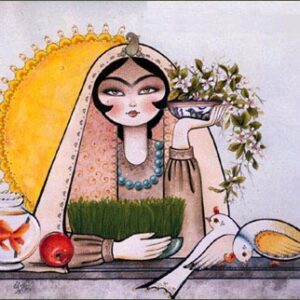
We’ve just opened a new aisle on the website. It focuses on the Persian New Year, or Nowrooz, so we thought it would be helpful to replicate this guide (which normally lives in our Persopaedia) so you know what it is all about. It will also ex[plain why your Iranian friends start to behave a bit oddly at this time of year.
Nowrooz, or the Persian New Year, falls this year on March 20th at 16:57:07pm. This is also, of course, the time of the spring equinox, the first day of spring. The timing is crucial – it is worked out according to the lunar calendar.
This year will be 1393 – the years are counted from the date of Mohammed’s flight from Mecca to Medina. However, just as with Christmas, Nowrooz is quintessentially a pagan festival. It has its origins in the way back in the mists of time, when the generally practised religion in Iran was Zoroastrianism, and there are strong elements of superstition woven into the customs surrounding it. On the eve of the last Wednesday of the year, for example, Iranians the world over light fires which they then jump over, addressing the flames as they go, shedding their bad deeds/luck and taking strength from the fire, purging themselves for another year.
Iranians decorate for the New Year – they prepare a special spread of items representing the regrowth and prosperity that they hope will come. There is the ‘HAFTSIN’ – the seven ‘S’s – seven items beginning with the letter S – you may choose from: SIB (apple), SIR (garlic), SAMENOU (a sweet paste), SOMBOL (hyacinth), SUMAK (a spice), SENJED (the fruit of the oleander), SIRKEH (vinegar), SABZEH (herbs), and SEKEH (a coin). The ‘sabzeh” is grown from wheat or bean sprouts a couple of weeks before the actual day. They will also have live (gold)fish to represent new life and loadsa sweeties (to bring sweetness into their lives)The NOWROOZ table will be set with painted eggs, mirrors, candles, and a copy of the Koran. It is awfully pretty.
On the actual day it is important to start the New Year as you hope to go on – pink and scrubbed, in new clothes, relaxed and happy, with a clear conscience and surrounded by your very nearest and dearest. As the clock strikes you hug and congratulate everyone, and then eat some of the vast number of sweetmeats in front of you. Gifts and money are given, especially to children, money being distributed by the elders from the pages of the Koran. In Iran there is then a period of great festivity – businesses and schools close for two weeks, and the time is spent visiting friends and feasting.
Finally, on the thirteenth day after the New Year, the sabzeh (which should now have grown quite high) is tied by the members of the family, as each one recites their wishes for the coming year, and then tossed into moving water. Oh, and (in case you were worried) the goldfish are released into ponds or proper aquariums. That’s it. Have a good one.

